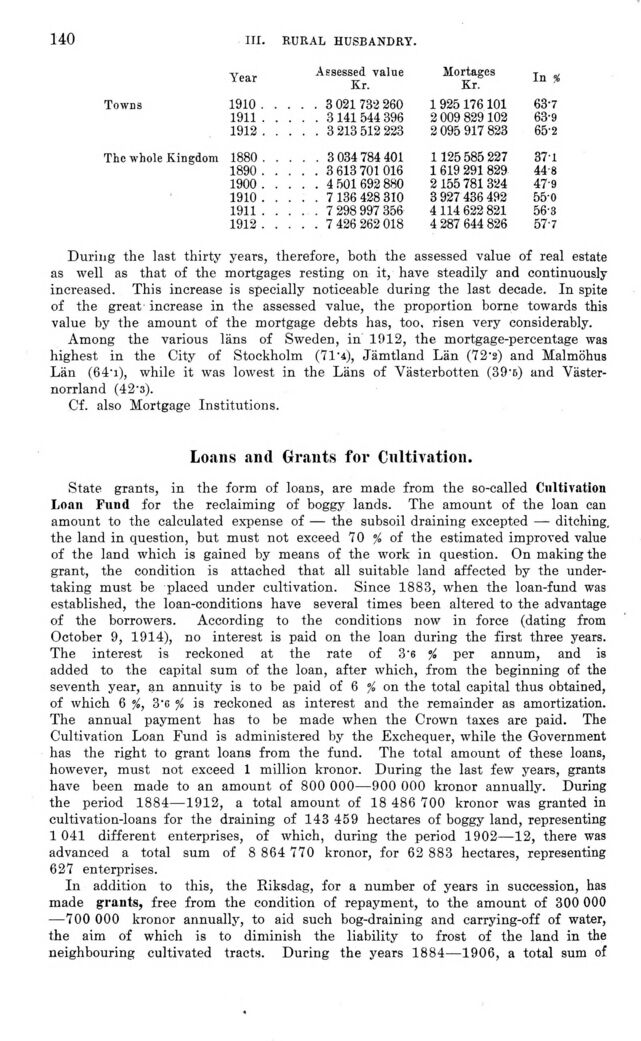
Full resolution (JPEG) - On this page / på denna sida - III. Rural Husbandry. Introd. by H. Juhlin Dannfelt - 4. Public and Private Institutions for the Advancement of Agriculture. Introd. by W. Flach - Mortgage on Real Estate. By O. Sederholm - Loans and Grants for Cultivation. By G. Sederholm

<< prev. page << föreg. sida << >> nästa sida >> next page >>
Below is the raw OCR text
from the above scanned image.
Do you see an error? Proofread the page now!
Här nedan syns maskintolkade texten från faksimilbilden ovan.
Ser du något fel? Korrekturläs sidan nu!
This page has never been proofread. / Denna sida har aldrig korrekturlästs.
1-2-2
iii. rural husbandry.
Assessed value Mortages
Kr. Kr.
Towns 1910 ..... 3 021732 260 1925176101 63*7
1911 ..... 3141 544 396 2 009 829 102 63’9
1912 ..... 3 213 512 223 2 095 917 823 65’2
The whole Kingdom 1880 ..... 3 034 784 401 1125 585 227 371
1890 ..... 3 613 701 016 1 619 291 829 44 8
1900 ..... 4 501 692 880 2 155 781 324 47’9
1910 ..... 7 136 428 310 3 927 436 492 55 0
1911 ..... 7 298 997 356 4 114 622 821 56’3
1912 ..... 7 426 262 018 4 287 644 826 57’7
During the last thirty years, therefore, both the assessed value of real estate
as well as that of the mortgages resting on it, have steadily and continuously
increased. This increase is specially noticeable during the last decade. In spite
of the great increase in the assessed value, the proportion borne towards this
value by the amount of the mortgage debts has, too, risen very considerably.
Among the various läns of Sweden, in 1912, the mortgage-percentage was
highest in the City of Stockholm (71’4), Jämtland Län (72"2) and Malmöhus
Län (64’i), while it was lowest in the Läns of Västerbotten (39’6) and
Västernorrland (42’3).
Cf. also Mortgage Institutions.
Loans and Grants for Cultivation.
State grants, in the form of loans, are made from the so-called Cultivation
Loan Fund for the reclaiming of boggy lands. The amount of the loan can
amount to the calculated expense of — the subsoil draining excepted — ditching,
the land in question, but must not exceed 70 % of the estimated improved value
of the land which is gained by means of the work in question. On making the
grant, the condition is attached that all suitable land affected by the
undertaking must be placed under cultivation. Since 1883, when the loan-fund was
established, the loan-conditions have several times been altered to the advantage
of the borrowers. According to the conditions now in force (dating from
October 9, 1914), no interest is paid on the loan during the first three years.
The interest is reckoned at the rate of 3’6 % per annum, and is
added to the capital sum of the loan, after which, from the beginning of the
seventh year, an annuity is to be paid of 6 % on the total capital thus obtained,
of which 6 %, 3"c % is reckoned as interest and the remainder as amortization.
The annual payment has to be made when the Crown taxes are paid. The
Cultivation Loan Fund is administered by the Exchequer, while the Government
has the right to grant loans from the fund. The total amount of these loans,
however, must not exceed 1 million kronor. During the last few years, grants
have been made to an amount of 800 000—900 000 kronor annually. During
the period 1884—1912, a total amount of 18 486 700 kronor was granted in
cultivation-loans for the draining of 143 459 hectares of boggy land, representing
1041 different enterprises, of which, during the period 1902—12, there was
advanced a total sum of 8 864770 kronor, for 62 883 hectares, representing
627 enterprises.
In addition to this, the Riksdag, for a number of years in succession, has
made grants, free from the condition of repayment, to the amount of 300 000
—700 000 kronor annually, to aid such bog-draining and carrying-off of water,
the aim of which is to diminish the liability to frost of the land in the
neighbouring cultivated tracts. During the years 1884—1906, a total sum of
<< prev. page << föreg. sida << >> nästa sida >> next page >>